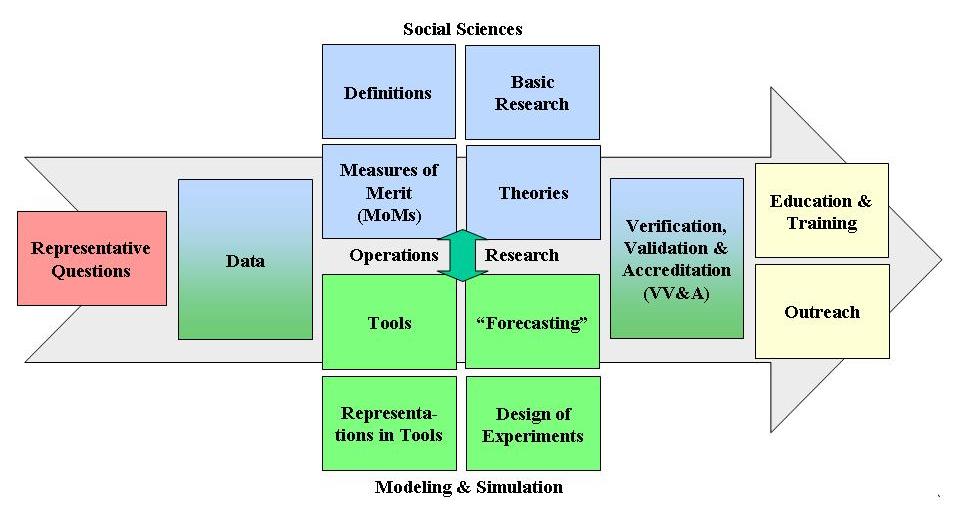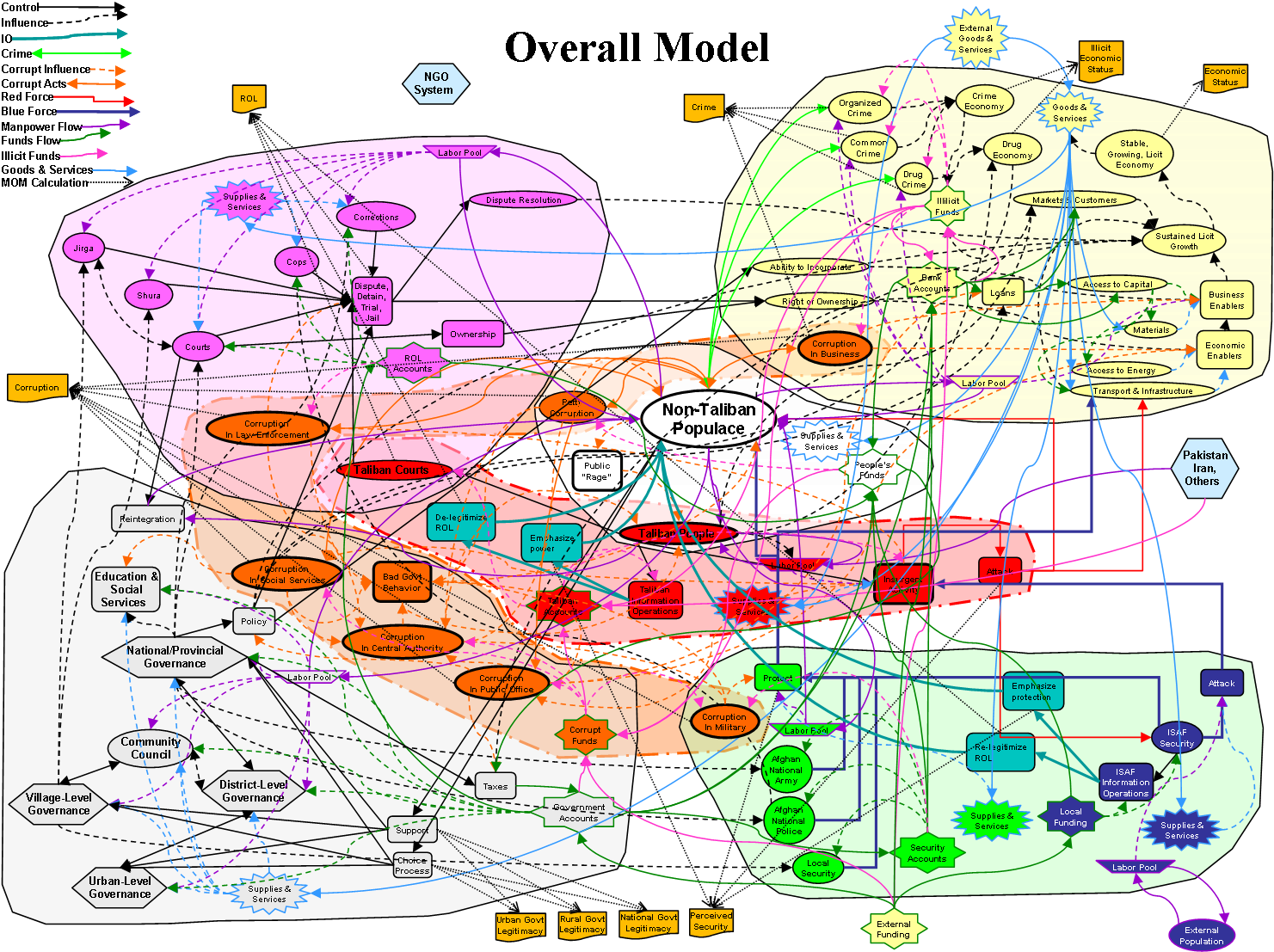
| Project Metadata | Keywords | ||||||||||||||||||||||||||||||||||||||||||||||||||||
|
|
The Director, BioSystems, DDR&E, is sponsoring work on Human, Social, and Cultural Behavior (HSCB). As part of this work, the Center for Technology and National Defense Policy (CTNSP) of the National Defense University (NDU) is organizing and conducting a series of workshops. These workshops investigate the needs for HSCB modeling, the current state of the art in HSCB modeling and the gaps between the needs and current modeling, and formulate a Science and Technology (S&T) roadmap to address the highest priority gaps. The results of the workshops will be used to justify the allocation of resources for HSCB modeling to the Office of the Secretary of Defense (OSD) and the Congress. This report describes the results of the first workshop, "Needs," and the second workshop, "COCOM Requirements."
The general DIME/PMESII background can be found in the discussion of Analytical Tools for OOTW.
The needs workshop was held on June 28 – 30, 2008 at NDU. Approximately 120 people attended the by-invitation-only workshop. The participants were selected from the government, academia, industry, and the Federally Funded Research and Development Centers (FFRDCs). The stated purpose of the workshop was the following:
Characterize the capabilities needed to perform effective HSCB modeling in support of operational users and senior decision makers.
A secondary purpose was the opportunistic capture of additional insights of the participants that would be helpful in supporting HSCB modeling.
The workshop was organized with plenary sessions, working group breakout sessions, and a wrap-up session. The first two days consisted of plenary sessions in the morning and working group sessions in the afternoon and involved all of the participants. The working groups were constructed with two divisions. The first day’s working groups were divided by discipline: micro-social sciences, macro-social sciences, operations research (OR), and Verification, Validation and Accreditation (VV&A) of models, data, methods, and theories. The second day’s working groups were divided by problem set: deterrence, counterterrorism (CT), counter insurgency (COIN), and Stability, Security, Transition, and Reconstruction Operations (SSTRO). The working groups were not segregated by individual specialties, but were composed of mixes of specialties to ensure full communication and surfacing of ideas from all points of view. In addition, each working group had participation by members of the Synthesis Group to ensure that valuable connections could be made among the separate sets of results.
The Combatant Command (COCOM) requirements workshop was held on June 8 - 10, 2009 at NDU. There were approximately 120 attendees, including participants from the COCOM user communities and participants from the social sciences, computational social sciences, and operations research communities. The goal of this workshop was the following:
Determine what HSCB tools need to be developed and what changes to doctrine, organization, training, materiel, leadership and education, personnel, and facilities (DOTMLPF) would be required to transition them efficiently and effectively, in a sustained manner, to the operational user.
The workshop was divided into two parts. The first part consisted of plenary briefings which characterized the nature of the problem, depicted the state-of-the-practice, and identified the steps needed to achieve desired capabilities. The second part consisted of four COCOM working groups which systematically addressed several key areas. They were asked to characterize the “As Is” HSCB process and the DOTMLPF factors associated with that process. Subsequently, they were asked to formulate recommendations to enhance key HSCB DOTMLPF factors.
The first data workshop was held on November 17, 2009 at NDU. There were 40+ attendees from various governmental agencies. The goal of the workshop was the following:
Develop recommendations to Irregular Warfare (IW) Modeling and Simulation (M&S) General Officer Steering Committee (GOSC) on how to bridge key data and analytical tool gaps.
The central driving force used to elicit results was a set of questions posed by MG Flynn concerning the AfPak region. These questions are divided into six categories: narrative shaping & strategic communications; situational awareness; Taliban-related; rule of law, norm building & governance; economics & corruption; and security.
The workshop was divided into two parts. The first part consisted of plenary briefings to ensure the participants started with a common understanding of the data being collected in the field and the nature of the data collection systems. The second part consisted of three working groups which systematically addressed several key areas. They were asked to clarify the nature of the problem, analyze MG Flynn's questions, discuss strawman data needs, explore options to prioritize data gaps, and provide overall recommendations.
The second data workshop was held on May 11-13, 2010 at NDU. There were approximately 100 participants from various government agencies, industry, academia, and from five foreign countries. The goal of the workshop was the following:
Develop recommendations concerning corruption in Afghanistan.
The workshop was divided into two parts. The first part consisted of plenary briefings to ensure the participants started with a common understanding of the data being collected in the field and the nature of the data collection systems. The second part consisted of four working groups (and a synthesis group) which systematically addressed the "four pillars": Governance, Rule of Law, Economic Development, and Security. Each of these groups created sets of recommendations for its area and also worked on a model of corruption for its area.
The figure illustrates the capabilities that need improvement to support HSCB modeling. The capabilities are represented as flowing from the Representative Questions of the stakeholders who need the results of HSCB modeling, with Operations Research as the mechanism for deriving the details and linking the resulting capabilities. The Social Sciences and Modeling & Simulation are shown as major categories, with Data and VV&A shown as spanning the two.

Figure 1. Capabilities needed for HSCB modeling
Within the Social Sciences, Definitions and Theories are needed to support Measures of Merit; however, Basic Research is needed to improve the situation. Within Modeling & Simulation, new and better Tools are needed, some of which should support "Forecasting" (a more forgiving term than "prediction"), decisions on the proper Representation in Tools of the correct elements are needed, and Design of Experiments techniques are needed to inform the use of the tools.
The remaining capabilities are Education & Training (of both the social scientists and the modeling personnel) to improve communication and Outreach to support better use and capability improvements from the stakeholders.
The link to the NDU site in the Details section leads to the detailed recommendations. A categorical summary is shown below:
| Recommendation Category | Number of Recommendations |
| Tools | 2 |
| VV&A | 2 |
| Data | 9 |
| Methodology | 4 |
| MoMs | 7 |
| Intellectual Capital | 5 |
| Education & Training | 7 |
| Research | 4 |
Integrating across the various working groups, the Synthesis Working Group identified five key steps that are needed to enhance the transition of the results of HSCB activities to the operational users.
First, it is important to develop a common lexicon (e.g., to enhance the communication among social scientists, operations analysts, and operational users).
Second, we need to develop a framework for examining needs, theoretical approaches, tools, and data. This framework will provide the basis for a rapid prototyping facility that will bridge the gap between the HSCB community and the operational user (see below).
Third, we need to adopt a rapid prototyping approach. In this approach, one would be able to show prototypes to potential users, elicit feedback, and to fast-track promising prototypes with the help of acquisition partners.
Fourth, we need to send unresolved issues back to research sponsors.
Finally, the workshop provided the basis for a HSCB Community of Interest/Community of Practice (COI/COP). The COI/COP can be used in future workshops to identify and prioritize key gaps. Ultimately, it will be desirable to augment the core of the COI/COP with additional interagency participants.
The link to the NDU site in the Details section leads to the detailed recommendations. The key findings are as follows:
It appears as if operational data will not fully support the needs of analysts
Operational data is at the tactical level
Many of the key policy issues are at the strategic
level
Steps should be taken to enhance data discovery
Needed data are widely distributed (e.g., DoD, Interagency, international, NGO)
This is a Whole of Society issue!
There is a major issue in integrating the available data
There is a need for ontologies, metadata, pedigree,…
The classification issue is of particular concern
The credibility issue must be addressed
There is little effort to verify and validate (V&V) the key data (e.g., accuracy, currency)
Discipline is required to plan for and execute V&V
Much of the available data are not usable by the analyst
There is an urgent need for standards
Clarification is needed on data structure,
transformation from qualitative to quantitative data
The working groups produced the following definitions:
They also produced the following general recommendations (and many specific ones):
Modeling: Fund technological solutions to draw correspondence with, and validate against, many uncertain data. Fund integrative frameworks to compose general models into specific localized scenarios. Fund agent based models of the emergence of institutions. Focus on analytic tools that address small sets of local priorities.
Operations:
- Focus resources through PRTs; however, recognize and mitigate the risk of
PRTs creating parallel structures to local governance. Understand and report
new processes.
- Strengthen Commanders ORSA team interoperability
IO: Initiate a credible IO campaign
- Protection success
- Re-legitimize traditional ROL and focus on building up utilization and
support for traditional courts. Explore options to bolster cooperation
between traditional and formal court systems.
Data: Employ “commander’s intent” to establish priority and focus for data gathering. Military data collection must include a common set of “agreed upon” objective indicators to back up a commander’s subjective assessment. Develop systemic view of MoMs, rather than individual views.
Each working group worked on a model. These pieces were melded into a single model and extended to produce a relatively consistent level of granularity. The resulting conceptual model illustrated in the figure below covers the Rule of Law pillar in the top left, the Economic pillar in the top right, the Governance pillar in the bottom left, and the Security pillar in the bottom right. The color coded arrows allow the model to be decomposed into an Entity model, a Measure of Merit (MOM) model, a Force model, an IO model, a Manpower model, a Goods & Services model, a Funds Flow model, a Control model, and Influence model, a Crime model, and a Corruption model.
 |
A PowerPoint file that builds the model can be found here.
You can find more information, including copies of the presentations at the NDU CTNSP website.
If you arrived here using a keyword shortcut, you may use your browser's "back" key to return to the keyword distribution page.
Return to Hartley's Projects Page